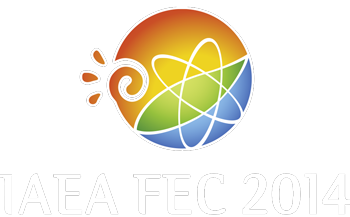Speaker
Mr
Leonid Klyuchnikov
(Institute of Tokamak Phisycs, National Research Centre "Kurchatov Institute", Moscow, Russia)
Description
Experiments on impurities removal with central ECR heating on T-10 were carried out with various plasma parameters. CXRS and Zeff measurements show removal of carbon nuclei from plasma during central ECRH.
There is a complex of high-power gyrotrons for ECRH experiments on T-10. Spectroscopic diagnostics of T-10 allows to measure carbon concentration by CXRS diagnostics [1] and to measure effective ion charge (Zeff) radial distribution from bremstrahlung intensity with subtraction of background molecular linear spectra.
Radial distribution of C+5 passive line intensity was measured simultaneously with CXRS measurements. This linear radiation allows to estimate ionization flux from C+5 into C+6 ions for calculation of C+6 particle confinement time τparticle:
Value of τparticle can be successfully defined only for impurities with relatively high Z (like carbon) due to the ionization flux into the nuclei in toroidal and poloidal coordinates for carbon impurity is homogeneous in T-10 conditions.
Carbon confinement time in OH regimes rises with increasing of line averaged electron density and decreasing of plasma current. In ECR heated regimes with PECR=1 MW one observes sharp decrease of carbon confinement time to a value τparticle≈23 ms, which is almost the same for various plasma parameters within the error limits.
The most contrast fall of τparticle is observed at high plasma densities when one observes sharp decrease of total carbon concentration during central ECRH, although carbon ionization flux in ECR regimes is about twice higher than in OH plasma.
Work was carried out by "Rosatom" 13.05.2013 № H.4x.44.90.13.1101
| Country or International Organisation | Russian Federation |
|---|---|
| Paper Number | EX/P1-44 |
Author
Mr
Leonid Klyuchnikov
(Institute of Tokamak Phisycs, National Research Centre "Kurchatov Institute", Moscow, Russia)
Co-authors
Dr
Aleksandr Borschegovskij
(Institute of Tokamak Phisycs, National Research Centre "Kurchatov Institute", Moscow, Russia)
Dr
Aleksey Dnestrovskij
(Institute of Tokamak Phisycs, National Research Centre "Kurchatov Institute", Moscow, Russia)
Mr
Aleksey Gorbunov
(Institute of Tokamak Phisycs, National Research Centre "Kurchatov Institute", Moscow, Russia)
Mr
Anton Nemets
(Institute of Tokamak Phisycs, National Research Centre "Kurchatov Institute", Moscow, Russia)
Dr
Gennadij Tilinin
(Institute of Tokamak Phisycs, National Research Centre "Kurchatov Institute", Moscow, Russia)
Dr
Igor Roy
(Institute of Tokamak Phisycs, National Research Centre "Kurchatov Institute", Moscow, Russia)
Mr
Kirill Korobov
(Institute of Tokamak Phisycs, National Research Centre "Kurchatov Institute", Moscow, Russia)
Mr
Nikolay Naumenko
(B.I. Stepanov Institute of physics NASB, Minsk, Republic of Belarus)
Mr
Sergey Krylov
(Institute of Tokamak Phisycs, National Research Centre "Kurchatov Institute", Moscow, Russia)
Dr
Sergey Tugarinov
(Institute of Tokamak Phisycs, National Research Centre "Kurchatov Institute", Moscow, Russia)
Dr
Vadim Krupin
(Institute of Tokamak Phisycs, National Research Centre "Kurchatov Institute", Moscow, Russia)
Mr
Viktor Nikulin
(Institute of Tokamak Phisycs, National Research Centre "Kurchatov Institute", Moscow, Russia)
Mr
Vyacheslav Korolev
(Institute of Tokamak Phisycs, National Research Centre "Kurchatov Institute", Moscow, Russia)

